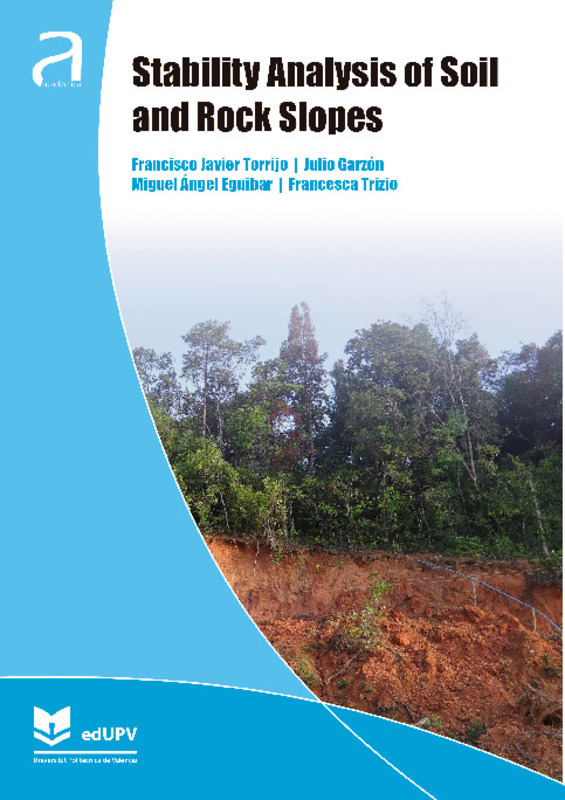JavaScript is disabled for your browser. Some features of this site may not work without it.
Buscar en RiuNet
Listar
Mi cuenta
Estadísticas
Ayuda RiuNet
Admin. UPV
Stability Analysis of Soil and Rock Slopes
Mostrar el registro sencillo del ítem
Ficheros en el ítem
| dc.contributor.author | Torrijo Echarri, Francisco Javier
|
es_ES |
| dc.contributor.author | Garzón Roca, Julio
|
es_ES |
| dc.contributor.author | Eguíbar Galán, Miguel Ángel
|
es_ES |
| dc.contributor.author | Trizio, Francesca
|
es_ES |
| dc.date.accessioned | 2022-07-29T08:28:08Z | |
| dc.date.available | 2022-07-29T08:28:08Z | |
| dc.date.issued | 2022-07-06 | es_ES |
| dc.identifier.isbn | 978-84-1396-037-1 | es_ES |
| dc.identifier.uri | http://hdl.handle.net/10251/184935 | |
| dc.description.abstract | The analysis of the stability of slopes is a key aspect in the design of any infrastructure such as roads, railways, canals, pipelines and dams as well as in mining operations. For common infrastructures, slopes reach heights up to 40 or 50 m, although slope of more than 200 m can be built on some occasions. These slopes should normally be projected as vertical as possible for economic reasons and must be stable in the long term. On the other hand, mining slopes are designed based on the mineral deposit to be exploited and may need to be stable exclusively for a short or medium term. The potential instability of slopes is not only related to infrastructures or mining operations, but it is also of high importance in other areas of Civil Engineering like land use planning, urbanism and environmental issues. Although many landslides take place in sparsely populated mountain areas where material damage and deaths are lower than the one produced by other hazards like floods or earthquakes, some slope instabilities around the world resulted in infamous disasters with a great amount of life losses. The consequences of these great disasters together with the fact that small landslides, even though can cause just a dozen victims, are very numerous, almost continuous throughout any year and always result in significant economic losses,shows the importance of analyzing slope stability and forecasting and preventing such kind of natural and man-made potential hazards. For that, this book shows the most relevant aspects for the student of Civil Engineering within the field of the stability of slope. | es_ES |
| dc.format.extent | 114 | es_ES |
| dc.format.medium | Físico | es_ES |
| dc.language | Inglés | es_ES |
| dc.publisher | Editorial Universitat Politècnica de València | es_ES |
| dc.relation.ispartof | Colección Académica | es_ES |
| dc.rights | Reserva de todos los derechos | es_ES |
| dc.subject | Stability | es_ES |
| dc.subject | Analysis | es_ES |
| dc.subject | Slopes | es_ES |
| dc.subject.classification | INGENIERIA DEL TERRENO | es_ES |
| dc.subject.classification | INGENIERIA HIDRAULICA | es_ES |
| dc.title | Stability Analysis of Soil and Rock Slopes | es_ES |
| dc.type | Libro | es_ES |
| dc.rights.accessRights | Cerrado | es_ES |
| dc.contributor.affiliation | Universitat Politècnica de València. Editorial | es_ES |
| dc.description.bibliographicCitation | Torrijo Echarri, FJ.; Garzón Roca, J.; Eguíbar Galán, MÁ.; Trizio, F. (2022). Stability Analysis of Soil and Rock Slopes. Editorial Universitat Politècnica de València. http://hdl.handle.net/10251/184935 | es_ES |
| dc.description.accrualMethod | EDITORIAL | es_ES |
| dc.relation.publisherversion | https://www.lalibreria.upv.es/portalEd/UpvGEStore/products/p_214-5-1 | es_ES |
| dc.type.version | info:eu-repo/semantics/publishedVersion | es_ES |
| dc.relation.pasarela | EDITORIAL\214_5_1 | es_ES |
| dc.subject.editorial | Ingeniería | es_ES |
| dc.subject.editorial | Civil | es_ES |
Este ítem aparece en la(s) siguiente(s) colección(ones)
-
Artículos, conferencias, monografías [48357]
-
Académica. Editorial UPV [362]






